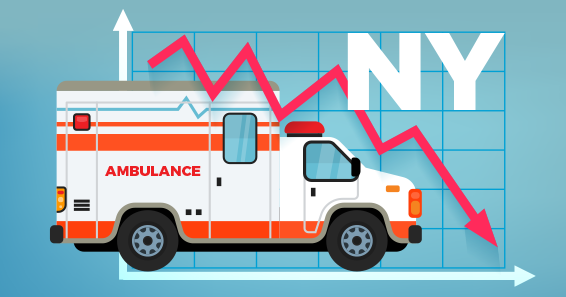New York State Braces for Loss of Reimbursement
April 1st
When New York Governor Andrew Cuomo presents his administration’s 2019 budget on April 1st, ambulance providers in the Empire State stand to experience a significant loss in reimbursement dollars at a time when making ends meet is as difficult as ever.

Cuomo is recommending that New York State slash Medicaid Crossover and Supplemental funding traditionally paid by the Medicaid program, there.
New York State is one of a handful of states that still reimburses EMS agencies for Medicaid Crossover claims and includes supplemental funding via the Medicaid payer system. Given the large amount of older New Yorkers using the EMS system on a daily basis, removing the payment of the 20% co-pay secondary to Medicare’s primary payment on claims will slash funding overall by an estimated $14 million on the low end with as much as $34 million predicted on the high end of the cuts.
In context…
Empire State ambulance administrators have been shocked to learn of Cuomo’s proposed deep cuts in Medicaid reimbursements.
To put this in the context of the overall ambulance reimbursement picture in New York, a 2017 New York State Department of Health report found EMS underfunded by Medicaid by $31.4 million. Most regions in New York now show a Medicare, Medicaid or combination of Medicare and Medicaid payer source at about 60 percent of the total patient population, meaning the cuts will affect most ambulance provider agencies in New York.
Cuomo’s proposed cuts have the potential to prove devastating for the ambulance industry with a majority of EMS services predicting their losses will check in at multiple tens and even hundreds of thousands of dollars which they will have no possibility of replacing.
By example, Medicare patients who are also eligible for Medicaid coverage, also known as the “dual eligibles,” will see their ambulance ride reimbursed first by Medicare’s initial funding at 80% of the National Medicare fee schedule allotment. National studies show that reimbursement rate to short-change ambulance companies below cost to the tune of somewhere between 6 and 10 percent, depending on the analysis methodology. At the present time, New York State EMS agencies have been able to collect the remaining 20% crossover payment to help alleviate some of the below-cost deficit.
Should Cuomo’s budget pass with the proposed cuts, ambulance industries will feel the full effect of the short-payment scenario even more severely, as only 80% of the Medicare fee schedule amount will be collected.
Protests and the Response
The United New York Ambulance Network (UNYAN) and other organizations have blown the siren about future peril for the New York State ambulance industry as a whole.
Commenting for an article published by The Spectator (Ambulances sound the alarm, 3/1/2019), David Butler, Chairman of UNYAN and CEO of TLC Medical Transportation Services of Central New York had this to say about the proposed budget cuts.
“For years, the statewide ambulance industry has been operating at a loss of over $31 million annually when it comes to Medicaid and Medicare reimbursements from the state. The elimination of this vital crossover funding will make it more difficult for ambulance services statewide to continue to serve the millions of New Yorkers who rely on our services every single day.”
So far, word from Albany has not been encouraging. In a statement issued by the New York State Division of the Budget, spokesman Morris Peters issued this short response to the ambulance industry protests.
“In situations where Medicare pays an appropriate amount, Medicaid need not pay more than it normally would. These changes, being taken for consistency, are not anticipated to have any adverse impacts on the availability of transport services.”
Recent Ambulance Closures
Contrary to the Governor’s position, ambulance companies across New York State are already being impacted by economic forces and they cite recent closures of long-standing ambulance service providers as proof.
Recently, Fulton County has experienced closures of two ambulance companies that served that upstate community for many years. Citing an unsustainable business model, the Ambulance Service of Fulton County (ASFC) ceased operations just one month ago. At the time, ASFC administrators noted that their average costs to respond to an emergency had climbed to $550 per response while the average reimbursement to cover those costs was a paltry $220 per emergency.
Tomorrow, a second ambulance service in the Fulton County area, the Johnstown Area Volunteer Ambulance Corps (JAVAC), in operation since 1971, ceases to provide ambulance services effectively March 16th.
These closures come as the memory of the 2016 bankruptcy of TransCare Ambulance remains as the nightmare it was for the New York City metro area. Fears of even more such potential closures loom larger on the horizon.
As one New York ambulance administrator recently summed up the plight of the state of EMS funding affairs in New York when he commented, “No industry can continue with the same capacity taking a 20% cut on its largest payer.”